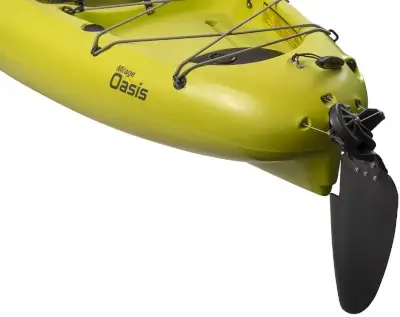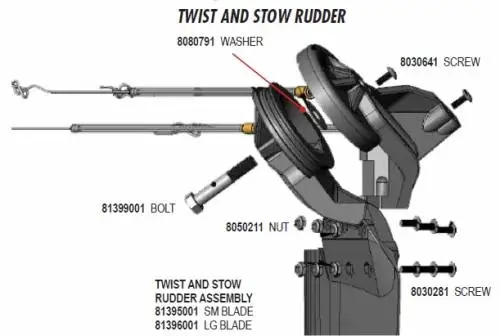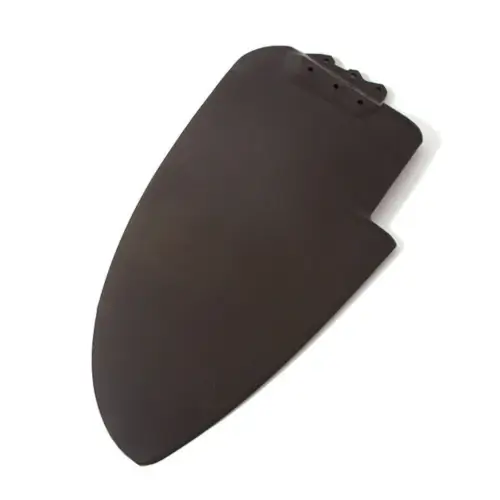 The Hobie Twist & Stow rudder system is a clever kayak rudder steering system that was incorporated into almost all models from 2007 and is still present on a few models today (Oasis, Revolution 11 & 13, and was also used on earlier model Outback, Outfitter, Sport and Adventure Island). Although highly effective at doing it’s job, the Twist & Stow system is a more complicated design than we see on newer models. Because of this it is more common for users to run into issues relating to operation, performance, maintenance and repair.
The Hobie Twist & Stow rudder system is a clever kayak rudder steering system that was incorporated into almost all models from 2007 and is still present on a few models today (Oasis, Revolution 11 & 13, and was also used on earlier model Outback, Outfitter, Sport and Adventure Island). Although highly effective at doing it’s job, the Twist & Stow system is a more complicated design than we see on newer models. Because of this it is more common for users to run into issues relating to operation, performance, maintenance and repair.
Failure to cleat the Rudder Down Line
Over the years we’ve been selling Hobie kayaks we have noted a few relatively common issues that arise from time to time. Perhaps the most common of them all is to hear from customers that are experiencing steering issues. Sometimes this is due to the rudder lines being poorly calibrated or are far too loose. But just as often we discover that the problems are a result of misuse and it is usually second hand kayak buyers who run into this, simply because no one ever showed them how to use it properly. Specifically, they simply weren’t aware that the rudder has to cleated down to perform optimally.
Its not enough to just pull the rudder down line to deploy the rudder – you also have to cleat it down. Failure to do this will result in a drifting rudder blade that makes it harder to turn the steering handle and the kayak will be inclined to veer off to one side. So if you’ve been having steering problems with a Hobie Twist & Stow rudder make sure you are cleating the rudder down firmly. On most models the cleat in question is a small black clam cleat (pictured below), and you will find it installed at the bottom corner of the right side mesh pocket. It’s easy to miss if you’re unaware of it, because it is fairly small and its black (and the mesh pocket frame it is attached to is also black). A few models use a Harken or Hobie Cam Cleat instead and these are positioned right at the rudder up line toggle.

If you’re pulling the rudder down line out to its full extension and this isn’t securing the rudder down firmly in place then it is likely that the rudder down line has stretched. Shortening the down line will probably resolve the issue, which you can test by moving the toggle down from the end of the line and tying a new stopper knot for the toggle. Don’t cut the excess cord from the line until you’ve found a stopper knot position that pulls the rudder down sufficiently.
Early model Adventure Islands used the Twist & Stow rudder system and this issue was highly pronounced on these models, which is probably why they designed the dynamic rudder system for the AI and TI. However newer Island dynamic rudder blades need to be cleated down firmly for optimal steering as well. Moral of the story is this: the tighter the rudder blade is cleated down the better it’s steering performance will be.
Rudder Line Tension
Other steering performance issues we see are most often attributed to poorly set rudder lines. To achieve optimal steering the left and right rudder lines need to be reasonably taught (not piano string tight), with an equal amount of tension on each line. This is generally pretty easy to rectify by tightening up each line. The important part in getting this right comes down to calibration between the rudder blade and steering handle when the line tension is set up. In short, when resetting line tension you need to make sure that the rudder blade is aligned in the centre position and that the steering handle is also positioned in the centre of its arc of movement.
If your rudder lines are in rough shape it might just be time to get them all replaced. Hobie do have a rudder line replacement kit available for this, although its generally perfectly feesable to simply replace the line itself. We sell factory replacement rudder line (per foot) as well as 2mm Dyneema cord (per metre) which does the job equally well.
We’d be lying if we told you that replacing all rudder lines was a simple job, but we’d also be exaggerating if we tried to tell you it was terribly tricky as well. It is a fiddely job and that can take an hour or so (more if you’ve never done it before) but most punters figure it out. If you’d rather not subject yourself to this chore you can always bring it in for us to do for you.
Sticky up and down / stowing and deployment
 Every now and then we get calls about early versions of the Twist & Stow rudder system, with users experiencing difficulty pulling the rudder up and down. Whenever we hear that the first thing we ask about is the condition of the rudder up and down lines to make sure they aren’t stretched or that the spring loaded bungee line hasn’t come adrift internally. If everything looks right the next thing we ask about is the rudder drum bolt (Part# 81399001).
Every now and then we get calls about early versions of the Twist & Stow rudder system, with users experiencing difficulty pulling the rudder up and down. Whenever we hear that the first thing we ask about is the condition of the rudder up and down lines to make sure they aren’t stretched or that the spring loaded bungee line hasn’t come adrift internally. If everything looks right the next thing we ask about is the rudder drum bolt (Part# 81399001).
Stiff twist action on the up and down rudder controls is usually very simple to address. If you’re having problems pulling the twist and stow rudder up and down on your Hobie kayak, first check to make sure you’re not trying to pull on the rudder ‘up’ line when the ‘down’ line is cleated in (which will make pulling it up near impossible). If the up and down movement of the rudder is stiff and difficult to operate with the up/down lines, the chances are high that your rudder drum bolt has worked itself tight. This is more likely the case on older models (pre 2015)
To check to see if this is the case, adjust the rudder drum bolt by backing it off slightly. Start small, perhaps just an 8th of a turn and see if it helps. If not wind it back a fraction more try that. Keep making fine adjustments until the rudder moves up and down freely. However avoid loosening it off so much that drums feel loose and wobbly about when operated.
If loosening the bolt does not free up the rudder up and down movement, it may be that one of the rudder lines is caught up on something internally inside the hull, or the rudder drum. In the case of the former you will need to inspect the rudder lines in the hull to make sure they aren’t obstructed or pinched in some way. In the case of the latter you might need to disassemble the rudder assembly, inspect the lines, clean out any grit from within the drum, check and replace the washer if required and reassemble.
If after trying this you’re unable to find or fix the source of the problem you should contact your local Hobie kayak dealer. Alternatively consult Hobie’s official Twist & Stow rudder repair guide (PDF)
How to improve Twist & Stow rudder steering performance
Providing your Twist & Stow rudder is operating as expected but you’re still looking to enhance the steering performance you could look into replacing the rudder blade with the Large Twist & Stow rudder blade. These were originally introduced on early model Adventure Islands but it didn’t take long for customers to start installing them on Outbacks and Revolution 13 models. Soon after Hobie included the large rudder blade as a standard part for the Tandem Oasis.
Its a little larger than the standard one, broader and deeper. As such it tends to steer the kayak with a little more authority, especially in chopper conditions.

Further Reading
